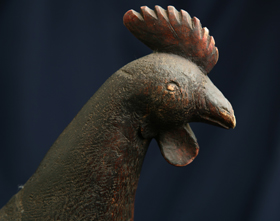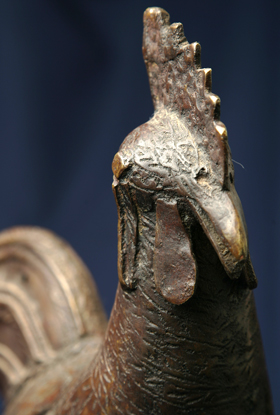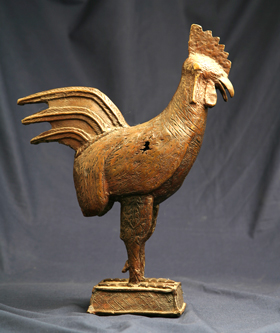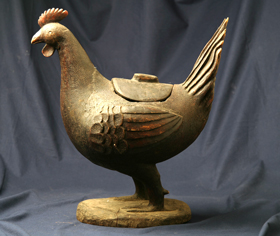| But ancient chicken DNA obtained from Easter Island may represent a genetic signature of an early Polynesian dispersal of chickens. |
|
Many would like to think so. Such evidence is used to support ancient trading contact between Polynesian and South American Indians. Some have passionately argued the case for pre-Colombian chickens, citing in particular the unusual Chilean Araucana and Passion Fowl breeds. The Araucana breed, for example, thought to be descended from indigenous Amerindian chickens, lays blue/green-shelled eggs and has distinctive plumage. Because features of its plumage are also found among Asian rather than Mediterranean chickens, it’s been hypothesized that the Araucana breed might have an Asian origin. A similar origin has been posited for Chile’s Passion Fowl. It is thought by some that these historic Chilean breeds could have arrived with early Polynesian or Dutch traders on the Pacific Coast of South America.
But a recent scientific paper published in the prestigious USA Proceedings of the National Academy of Sciences (29 July 2008) says that molecular evidence counters such an early introduction via Polynesia. Results of this research investigation into the putative ancient Polynesian lineage of Chile’s native chickens indicate an Indo-European genetic origin. This paper has generated a lively debate that is still on-going. (See, for example, the subsequent Letter to the Editor of PNAS from Storey.)
Interestingly, although this molecular evolutionary detective work provides no support for a pre-Colombian Polynesian introduction of chickens to South America, DNA sequences from ancient chicken remains obtained from two archaeological sites on Easter Island represent a genetic signature of an early Polynesian, rather than 15th century Spanish, introduction of chickens to the island.
But at present, there is no evidence to support an ancient Asia Pacific route for the introduction of Indo-European chickens into Chile.
‘The origin of South America’s first chickens remains debatable today,’ says Han Jianlin, an author of this paper, who heads the ILRI-Chinese Joint Lab in Beijing. ‘But I predict that we will have the definitive answer within the next five years. That’s how fast this molecular detective work is moving.’ ‘What is remarkable about this work,’ says Olivier Hanotte, another ILRI author of the paper, who leads an ILRI project to characterize indigenous animal genetic resources of the developing world, ‘is that it is allowing us to tackle major questions about human history that we would not have been able even to ask just 20 years ago.’
‘We didn’t set out in this research,’ says Hanotte, ‘to advance understanding of the history of the world’s farming societies. But that’s just where this research—conducted to characterize chicken genetic resources of and for the poor—has led us.~ OR Han Jianlin |
Category Archives: South America
The time is now
The world’s first Global Plan of Action for Animal Genetic Resources was agreed at a recent FAO conference in Switzerland from 3 to 7 September. While international negotiations continue, much can be done now, before it’s too late.
The First International Technical Conference on Animal Genetic Resources for Food and Agriculture, held in Interlaken in September, was a week-long series of negotiations organized by the Food and Agriculture Organization of the United Nations (FAO) and hosted by the Government of Switzerland to consider the current state of the world’s animal genetic resources and to reach international agreement on the best ways forward to protect these resources for long-term use. The conference opened with the launch of the world’s first report on the status of farm animal genetic resources, The State of the World’s Animal Genetic Resources. By the end of the conference, the world’s first Global Plan of Action for Animal Genetic Resources had been agreed by representatives from 109 countries. The global plan identifies four high-priority areas for animal genetic resources: characterization, inventory and monitoring of trends and risks, sustainable use and development, conservation and policies, institutions and capacity building.
Progress made at the Interlaken Conference includes:
- Agreement on a global plan for identifying and conserving valuable livestock species
- Agreement that livestock keepers rights are fundamental and need to be considered as part of an inclusive and equitable global plan
- Agreement that incentives need to be provided to help the traditional custodians of indigenous animal genetic resources—usually small-scale livestock keepers—continue to keep their native breeds.
Overview of the Interlaken conference
On the first day of the conference, ILRI’s director general, Carlos Seré, presented a paper on ‘Dynamics of Livestock Production Systems, Drivers of Change and Prospects for Animal Genetic Resources’. He identified key drivers of change, how they were influencing current trends and future prospects, and their impacts on the management of animal genetic resources for food and agriculture.
Seré identified four drivers: economic development and globalization, changing market demands, environmental impacts and trends in science and technology. He described the trends in livestock production in industrial, crop-livestock and pastoral systems, emphasizing that while the trends are occurring in both developing and industrialized countries, the outcomes are different. In the developing world, some trends are reducing the ability of livestock keepers to improve their livelihoods, reduce their poverty and manage their natural resources. The industrial livestock production systems of developed countries have already greatly narrowed the livestock genepool, reducing our ability to deal with future uncertainties, such as climate change and zoonotic diseases.
Local breeds being crowded out
During the presentation, the ILRI director general cited replacement of indigenous tropical breeds with exotic animals as a key reason for the erosion of genetic diversity. Local breeds are estimated to be disappearing at the rate of one a month. This concern was echoed by the representative from the League for Pastoral Peoples and Endogenous Livestock Development. Ilse Köhler-Rollefson stated that policies relating to the introduction of exotic breeds and subsidies were helping large-scale production systems but hurting pastoralists.
Seré stressed that conserving our livestock genetic resources required appropriate institutional and policy frameworks and concerted international efforts. As these negotiations will take time, Seré proposed four complementary actions to improve the management of animal genetic resources and maintain our genetic options for the future. These are: provide incentives for in situ conservation of local breeds (‘keep it on the hoof’); facilitate movement of breeds within and between countries (‘move it or lose it’); match breeds to environments (‘livestock landscape genomics’); and establish genebanks (‘put some in the bank’).
These four strategies are practical steps that can help conserve indigenous tropical breeds. Seré cautioned that if actions are not taken now, it could be too late for some breeds that will soon be lost to the world forever.
Media help to raise awareness of ‘livestock meltdown’
There was extensive media coverage of the FAO Interlaken conference, with regional and international press and radio and local African TV all helping to raise awareness of the ‘livestock meltdown’ taking place.
Local livestock breeds at risk: Nature (3 September 2007) reported that indigenous animals are dying out as commercial breeds sweep the world.
‘Many of the world’s indigenous livestock breeds are in danger of dying out as commercial breeds take over, according to a worldwide inventory of animal diversity.
‘Their extinction would mean the loss of genetic resources that help animals overcome disease and drought, particularly in the developing world, say livestock experts.’
Read the full article at http://www.nature.com/news/2007/070903/full/070903-2.html (subscription required).
A ‘livestock meltdown’ is occurring as hardy African, Asian and Latin American farm animals face extinction
| Scientists Call for Rapid Establishment of Livestock Genebanks To Conserve Indigenous Breeds |
|
With the world’s first global inventory of farm animals showing many breeds of African, Asian, and Latin American livestock at risk of extinction, scientists from the Consultative Group on International Agricultural Research (CGIAR) today called for the rapid establishment of genebanks to conserve the sperm and ovaries of key animals critical for the global population’s future survival. An over-reliance on just a few breeds of a handful of farm animal species, such as high-milk-yielding Holstein-Friesian cows, egg-laying White Leghorn chickens, and fast-growing Large White pigs, is causing the loss of an average of one livestock breed every month according to a recently released report by the UN Food and Agriculture Organization (FAO). The black-and-white Holstein-Friesian dairy cow, for example, is now found in 128 countries and in all regions of the world. An astonishing 90 percent of cattle in industrialized countries come from only six very tightly defined breeds. The report, “The State of the World’s Animal Genetic Resources,” compiled by FAO, with contributions by the International Livestock Research Institute (ILRI) and other research groups, surveyed farm animals in 169 countries. Nearly 70 percent of the entire world’s remaining unique livestock breeds are found in developing countries, according to the report, which was presented to over 300 policy makers, scientists, breeders, and livestock keepers at the First International Technical Conference on Animal Genetic Resources, held in Interlaken, Switzerland, from 3-7 September 2007. “Valuable breeds are disappearing at an alarming rate,” said Carlos Seré, Director General of ILRI. “In many cases we will not even know the true value of an existing breed until it’s already gone. This is why we need to act now to conserve what’s left by putting them in genebanks.” In a keynote speech at the scientific forum on the opening day of the Interlaken conference, Seré called for the rapid establishment of genebanks in Africa as one of four practical steps to better characterize, use, and conserve the genetic basis of farm animals for the livestock production systems around the world. “This is a major step in the right direction,” said Seré. “The international community is beginning to appreciate the seriousness of this loss of livestock genetic diversity. FAO is leading inter-governmental processes to better manage these resources. These negotiations will take time to bear fruit. Meanwhile, some activities can be started now to help save breeds that are most at risk.” ILRI, whose mission is poverty reduction through livestock research for development, helps countries and regions save their specially adapted breeds for future food security, environmental sustainability, and human development. Industrialized countries built their economies significantly through livestock production and there is no indication that developing countries will be any different. Worldwide today, one billion people are involved in animal farming and 70 percent of the rural poor depend on livestock as an important part of their livelihoods. “For the foreseeable future,” says Seré, “farm animals will continue to create means for hundreds of millions of people to escape absolute poverty.” In recent years, many of the world’s smallholder farmers abandoned their traditional animals in favor of higher yielding stock imported from Europe and the US. For example, in northern Vietnam, local breeds comprised 72 percent of the sow population in 1994, and within eight years, this had dropped to just 26 percent. Of the country’s fourteen local pig breeds, five are now vulnerable, two are in critical state, and three are facing extinction. Scientists predict that Uganda’s indigenous Ankole cattle—famous for their graceful and gigantic horns—could face extinction within 50 years because they are being rapidly supplanted by Holstein-Friesians, which produce much more milk. During a recent drought, some farmers that had kept their hardy Ankole were able to walk them long distances to water sources while those who had traded the Ankole for imported breeds lost their entire herds. Seré notes that exotic animal breeds offer short-term benefits to their owners because they promise high volumes of meat, milk, or eggs, but he warned that they also pose a high risk because many of these breeds cannot cope with unpredictable fluctuations in the environment or disease outbreaks when introduced into more demanding environments in the developing world. Cryo-banking Sperm and Eggs Seré proposes acceleration of four practical steps to better manage farm animal genetic resources. 1.) A first strategy is to encourage farmers to keep genetic diversity “on the hoof,” which means maintaining a variety of indigenous breeds on farms. In his speech, Seré called for the use of market-incentives and good public policy that make it in the farmer’s self-interest to maintain diversity. “In the US, Europe, China, India, and South America, there are well-established genebanks actively preserving regional livestock diversity,” said Seré. “Sadly, Africa has been left wanting and that absence is sorely felt right now because this is one of the regions with the richest remaining diversity and is likely to be a hotspot of breed losses in this century.” But setting up genebanks is a first important step towards a long-term insurance policy for livestock. Seré noted that genebanks by themselves are not the only answer to conservation, particularly if they end up becoming “stamp collections” that are never used. “Individual countries are already conserving their unique animal genetic resources. The international community needs to step forward in support,” said Seré. “We support FAO’s call to action and the CGIAR stands ready to assist the international community in putting these words into action.” Related information: What Makes Livestock Conservation So Different from Plant Conservation?
North-to-South Livestock Gene Flows Crowd out Local Breeds
Livestock breeds face ‘meltdown’ (BBC News)
Visit the online press room for further information and a series of short films and high-quality images of the third world’s unique farm animal breeds. |
Protecting breeds for people
| Animal Genetic Resources Are a Key Tool for Coping with Change in the Livestock Sector | |
|
Livestock are ubiquitous in the developing world. The ‘big five’—cattle, sheep, goats, poultry and pigs—as well as 9 other popular farm animals and 26 or so more specialized species are raised by more than half a billion people either on pastoral rangelands by nomadic herders, or on mixed farms by smallholders who raise crops along with livestock, or in peri-urban areas by people who raise a few animals in their backyards. All of these small-scale livestock enterprises matter to developing-country governments because livestock account for some 30 per cent of their agricultural gross domestic product, a figure expected to rise to 40 per cent by the year 2030. The diverse livestock production systems, like most crop production systems, are changing in response to globalization, urbanization, environmental degradation, climate change and science and technology. But the fastest changes are occurring within the livestock systems. That’s because the developing world’s rising human populations and household incomes are causing demand for milk, meat, eggs and other livestock foods to soar. As one would expect, livestock markets are growing and changing to serve that growing demand. What’s less appreciated are the changes being wrought by many of the billion-plus small-scale livestock keepers and sellers of the developing world who are changing the way they do business to help meet that growing demand. The rate of change within the livestock sector is so rapid that many local populations of livestock developed by small-scale farmers over millennia no longer have time to evolve adaptations to their new circumstances or the new needs of their owners. They are simply dying out, and at unprecedented and accelerating rates. The Food and Agriculture Organization of the United Nations estimates that on average a breed disappears every month and that 20 per cent of our uniquely adapted breeds of domestic animals are at risk of extinction. Over the last 150 years, farmers in industrialized countries supplanted their indigenous farm animals with a few high-producing breeds of a few species (chickens, pigs, cattle) suited to highly intensified production systems. The result is that 70 per cent of the world’s known livestock genetic diversity now resides on small farms and in remote regions of developing countries. With all the challenges facing developing countries and their one billion people living on less than a dollar a day, the question arises as to what immediate practical and cost-effective steps could be taken to preserve the wealth of their livestock genetic diversity. From a research viewpoint, it’s clear that if we’re going to manage the world’s remaining livestock genetic resources well, we’ll have to characterize the remaining populations to decide which are worth saving and why, we’ll have to find ways of broadening use of those populations deemed useful, and we’ll have to conserve the most important livestock genetic diversity for possible future use—by poor and rich farmers alike. From a political viewpoint, we’ll need new and appropriate institutional and policy frameworks, as well as lots of policy discussions, to find ways to strengthen national and international programs that support the conservation of livestock biodiversity. While the political issues are being discussed at length at national and inter-governmental fora, four practical things can be started immediately to ensure that the world’s remaining livestock biodiversity is conserved for future generations.
How science can help On-going breakthroughs in livestock reproductive technologies and functional genomics, for example, as well as in the information fields of bioinformatics and spatial analysis, are being systematically marshaled for the first time to address this challenge.. And policy and agricultural systems analysts are today articulating more judicious thinking about the production and funding of global public goods. Finally, whereas societies and countries tend to differ in their short-term interests in livestock production, their long-term interests—such as learning how to cope with unforeseen changes in livestock production systems and their environments—tend to converge. This creates real opportunities for international scientific, environmental and aid agencies to work with developing countries in collective action to conserve the world’s remaining livestock genetic diversity. Visit the online press room for further information and a series of short films and high-quality images of the third world’s unique farm animal breeds. |









